Maize Plant Morphology Affects Resistance to Stalk Breaking by Affecting Plant Stress
Abstract
1. Introduction
2. Results
2.1. Critical Wind Speed of Stalk Breaking
2.2. Torque
2.3. Leaf Area
2.4. Plant Fresh Weight
2.5. Height of Center of Gravity
2.6. Factors Affecting the Critical Wind Speed of Maize Stalk Breakage and Torque
3. Discussion
4. Materials and Methods
4.1. Experimental Treatment Design
4.2. Measurement and Methods
- (1)
- (2)
- Fresh weight of the plant: Following plant morphology measurements, the fresh weight of the whole plant was recorded. At the conclusion of the fan test, the ear leaf sheath was removed to fully expose the ear, and the fresh weight of the female ear was measured after complete removal.
- (3)
- Leaf area: The length (L) and width (W) of the longest and widest portions of each leaf were measured using a ruler. The total leaf area of the plant was determined by summing the areas of all of the leaves. The single leaf area was calculated using the formula:
- (4)
- Critical wind speed of stalk breaking: A self-developed crop lodging resistance measurement device was used to determine the critical wind speed (Figure 8). The plant was cut at the base and fixed vertically on a bracket at the first internode above ground level. The plant was positioned 40 cm away from the air outlet, with the base of the plant set 30 cm above the outlet. The wind speed was increased gradually at a constant rate, with ten wind speed levels set based on motor frequency (0–50 Hz): 3.1 m s−1, 6.9 m s−1, 10.8 m s−1, 14.6 m s−1, 18.5 m s−1, 22.4 m s−1, 26.2 m s−1, 30.1 m s−1, 33.9 m s−1, and 37.8 m s−1. The wind speed at which the plant bent and subsequently broke was recorded as the critical wind speed of stalk breaking.
- (5)
- Plant torque: After measuring the critical wind speed of stalk breaking, plant torque under different wind speed conditions was determined using a torque meter (Figure 8c). The torque measured in this study was generated by external forces, including wind and gravity. Torque will no longer be recorded when the stalk breaks.
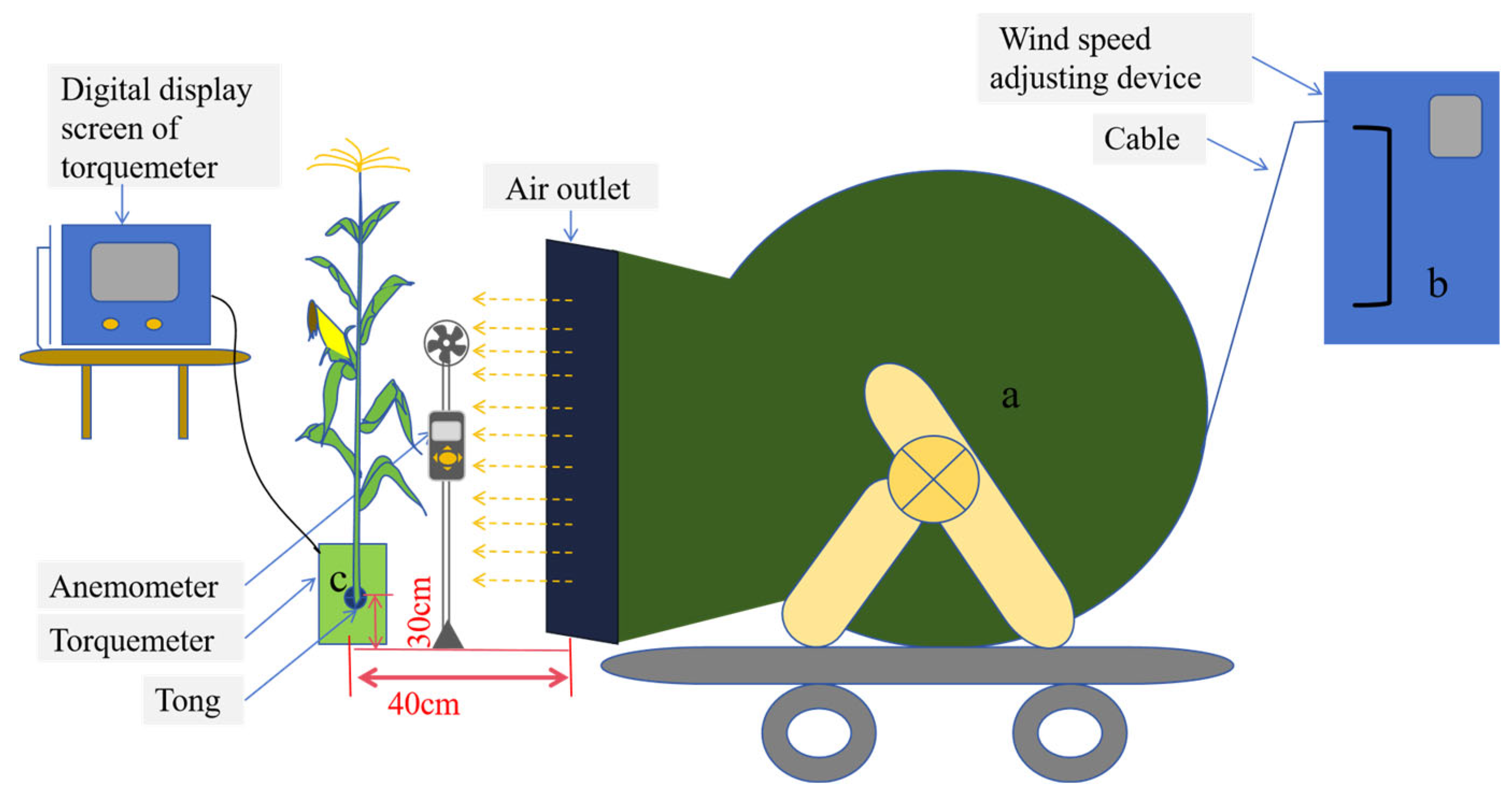
4.3. Data Analysis
5. Conclusions
Author Contributions
Funding
Data Availability Statement
Conflicts of Interest
Abbreviations
| U | Wind speed |
References
- Luo, N.; Meng, Q.; Feng, P.; Qu, Z.; Yu, Y.; Liu, D.L.; Wang, P. China can be self-sufficient in maize production by 2030 with optimal crop management. Nat. Commun. 2023, 14, 2637. [Google Scholar] [CrossRef] [PubMed]
- Martinez-Vazquez, P. Crop lodging induced by wind and rain. Agric. For. Meteorol. 2016, 228, 265–275. [Google Scholar] [CrossRef]
- Niu, Y.; Chen, T.; Zhao, C.; Zhou, M. Lodging prevention in cereals: Morphological, biochemical, anatomical traits and their molecular mechanisms, management and breeding strategies. Field Crops Res. 2022, 289, 108733. [Google Scholar] [CrossRef]
- Fu, Q.; Fu, J.; Chen, Z.; Zhao, R.; Ren, L. Design and experimental study of a spiral auxiliary feeding device for lodged corn on a combine harvester. J. ASABE 2022, 65, 31–38. [Google Scholar] [CrossRef]
- Sun, Q.; Gu, X.; Chen, L.; Qu, X.; Zhang, S.; Zhou, J.; Pan, Y. Hyperspectral estimation of maize (Zea mays L.) yield loss under lodging stress. Field Crops Res. 2023, 302, 109042. [Google Scholar] [CrossRef]
- Guo, Y.; Hu, Y.; Chen, H.; Yan, P.; Du, Q.; Wang, Y.; Li, W.X. Identification of traits and genes associated with lodging resistance in maize. Crop J. 2021, 9, 1408–1417. [Google Scholar] [CrossRef]
- Xue, J.; Ming, B.; Xie, R.; Wang, K.; Hou, P.; Li, S. Evaluation of maize lodging resistance based on the critical wind speed of stalk breaking during the late growth stage. Plant Methods 2020, 16, 148. [Google Scholar] [CrossRef]
- Lindsey, A.J.; Carter, P.R.; Thomison, P.R. Impact of imposed root lodging on corn growth and yield. Agron. J. 2021, 113, 5054–5062. [Google Scholar] [CrossRef]
- Yao, Y.; Yue, J.; Liu, Y.; Yang, H.; Feng, H.; Shen, J.; Liu, Q. Classification of maize growth stages based on phenotypic traits and UAV remote sensing. Agriculture 2024, 14, 1175. [Google Scholar] [CrossRef]
- Qun, W.; Jun, X.; Xie, R.; Li, S. Key indicators affecting maize stalk lodging resistance of different growth periods under different sowing dates. J. Integr. Agric. 2020, 19, 2419–2428. [Google Scholar] [CrossRef]
- Carter, P.R.; Hudelson, K.D. Influence of simulated wind lodging on corn growth and grain yield. J. Prod. Agric. 1988, 1, 295–299. [Google Scholar] [CrossRef]
- Minami, M.; Ujihara, A. Effects of lodging on dry matter production, grain yield and nutritional composition at different growth stages in maize (Zea mays L.). Jpn. J. Crop Sci. 1991, 60, 107–115. [Google Scholar] [CrossRef]
- Cai, T.; Peng, D.; Wang, R.; Jia, X.; Qiao, D.; Liu, T.; Ren, X. Can intercropping or mixed cropping of two genotypes enhance wheat lodging resistance? Field Crops Res. 2019, 239, 10–18. [Google Scholar] [CrossRef]
- Zhang, P.; Gu, S.; Wang, Y.; Yang, R.; Yan, Y.; Zhang, S.; Wang, P. Morphological and mechanical variables associated with lodging in maize (Zea mays L.). Field Crops Res. 2021, 269, 108178. [Google Scholar] [CrossRef]
- Yang, J.; Meng, X.; Yang, S.; Yang, J.; Li, Z.; Yang, Q.; Wang, L. A simple method for lodging resistance evaluation of maize in the field. Front. Plant Sci. 2023, 13, 1087652. [Google Scholar] [CrossRef]
- Guo, Q.; Chen, R.; Sun, X.; Jiang, M.; Sun, H.; Wang, S.; Ma, L.; Yang, Y.; Hu, J. A Non-Destructive and Direction-Insensitive Method Using a Strain Sensor and Two Single Axis Angle Sensors for Evaluating Corn Stalk Lodging Resistance. Sensors 2018, 18, 1852. [Google Scholar] [CrossRef]
- Cook, D.D.; De La Chapelle, W.; Lin, T.C.; Lee, S.Y.; Sun, W.; Robertson, D.J. DARLING: A device for assessing resistance to lodging in grain crops. Plant Methods 2019, 15, 102. [Google Scholar] [CrossRef]
- Niu, L.; Feng, S.; Ru, Z.; Li, G.; Zhang, Z.; Wang, Z. Rapid determination of single-stalk and population lodging resistance strengths and an assessment of the stem lodging wind speeds for winter wheat. Field Crops Res. 2012, 139, 1–8. [Google Scholar] [CrossRef]
- Seegmiller, W.H.; Graves, J.; Robertson, D.J. A novel rind puncture technique to measure rind thickness and diameter in plant stalks. Plant Methods 2020, 16, 44. [Google Scholar] [CrossRef]
- Cook, D.D.; Meehan, K.; Asatiani, L.; Robertson, D.J. The effect of probe geometry on rind puncture resistance testing of maize stalks. Plant Methods 2020, 16, 65. [Google Scholar] [CrossRef]
- Stubbs, C.J.; McMahan, C.; Seegmiller, W.; Cook, D.D.; Robertson, D.J. Integrated Puncture Score: Force–displacement weighted rind penetration tests improve stalk lodging resistance estimations in maize. Plant Methods 2020, 16, 113. [Google Scholar] [CrossRef]
- Chang, H.S.; Loesch, P.J., Jr.; Zuber, M.S. Effects of Recurrent Selection for Crushing Strength on Morphological and Anatomical Stalk Traits in Corn 1. Crop Sci. 1976, 16, 621–625. [Google Scholar] [CrossRef]
- Ma, F.; Shen, Y.; Su, D.; Adnan, M.; Wang, M.; Jiang, F.; Huang, J. A high-throughput phenotyping assay for precisely determining stalk crushing strength in large-scale sugarcane germplasm. Front. Plant Sci. 2023, 14, 1224268. [Google Scholar] [CrossRef] [PubMed]
- Tabaracci, K.; Bokros, N.T.; Oduntan, Y.; Kunduru, B.; DeKold, J.; Mengistie, E.; Robertson, D.J. Biomechanical phenotyping pipeline for stalk lodging resistance in maize. MethodsX 2024, 12, 102562. [Google Scholar] [CrossRef] [PubMed]
- Robertson, D.; Smith, S.; Gardunia, B.; Cook, D. An improved method for accurate phenotyping of corn stalk strength. Crop Sci. 2014, 54, 2038–2044. [Google Scholar] [CrossRef]
- Stubbs, C.J.; Seegmiller, K.; McMahan, C.; Sekhon, R.S.; Robertson, D.J. Diverse maize hybrids are structurally inefficient at resisting wind induced bending forces that cause stalk lodging. Plant Methods 2020, 16, 67. [Google Scholar] [CrossRef]
- Robertson, D.J.; Lee, S.Y.; Julias, M.; Cook, D.D. Maize stalk lodging: Flexural stiffness predicts strength. Crop Sci. 2016, 56, 1711–1718. [Google Scholar] [CrossRef]
- Robertson, D.J.; Julias, M.; Lee, S.Y.; Cook, D.D. Maize stalk lodging: Morphological determinants of stalk strength. Crop Sci. 2017, 57, 926–934. [Google Scholar] [CrossRef]
- Shah, D.U.; Reynolds, T.P.; Ramage, M.H. The strength of plants: Theory and experimental methods to measure the mechanical properties of stems. J. Exp. Bot. 2017, 68, 4497–4516. [Google Scholar] [CrossRef]
- Liu, Y.; Nie, C.; Zhang, Z.; Wang, Z.; Ming, B.; Xue, J.; Jin, X. Evaluating how lodging affects maize yield estimation based on UAV observations. Front. Plant Sci. 2023, 13, 979103. [Google Scholar] [CrossRef]
- Luo, X.; Wu, Z.; Fu, L.; Dan, Z.; Yuan, Z.; Liang, T.; Wu, X. Evaluation of lodging resistance in rice based on an optimized parameter from lodging index. Crop Sci. 2022, 62, 1318–1332. [Google Scholar] [CrossRef]
- Wen, W.; Gu, S.; Xiao, B.; Wang, C.; Wang, J.; Ma, L. In situ evaluation of stalk lodging resistance for different maize (Zea mays L.) cultivars using a mobile wind machine. Plant Methods 2019, 15, 96. [Google Scholar] [CrossRef] [PubMed]
- Xue, J.; Ming, B.; Wang, K.; Xie, R.; Hou, P.; Li, S. Device for determining critical wind speed of stalk breaking to evaluate maize lodging resistance. Int. J. Agric. Biol. Eng. 2020, 13, 1–7. [Google Scholar] [CrossRef]
- Molina-Aiz, F.D.; Valera, D.L.; Alvarez, A.J.; Madueño, A. A wind tunnel study of airflow through horticultural crops: Determination of the drag coefficient. Biosyst. Eng. 2006, 93, 447–457. [Google Scholar] [CrossRef]
- Sase, S.; Kacira, M.; Boulard, T.; Okushima, L. Wind tunnel measurement of aerodynamic properties of a tomato canopy. Trans. ASABE 2012, 55, 1921–1927. [Google Scholar] [CrossRef]
- Baker, C.J.; Sterling, M.; Berry, P. A generalised model of crop lodging. J. Theor. Biol. 2014, 363, 1–12. [Google Scholar] [CrossRef]
- Foley, D.C.; Clark, R.L. Mechanical Properties of Maize Stalks from the Plant Introduction Collection 1. Crop Sci. 1984, 24, 1116–1118. [Google Scholar] [CrossRef]
- Baker, C.J.; Berry, P.M.; Spink, J.H.; Sylvester-Bradley, R.; Griffin, J.M.; Scott, R.K.; Clare, R.W. A method for the assessment of the risk of wheat lodging. J. Theor. Biol. 1998, 194, 587–603. [Google Scholar] [CrossRef]
- Barimavandi, A.R.; Sedaghathoor, S.; Ansari, R. Effect of different defoliation treatments on yield and yield components in maize (Zea mays L.) cultivar of S. C704. Aust. J. Crop Sci. 2010, 4, 9–15. [Google Scholar]
- Jahan, M.N.; Hasan, M.A.; Islam, M.R. Effect of Defoliation on Growth and Yield of Maize. Bangladesh Agron. J. 2022, 25, 31–41. [Google Scholar] [CrossRef]
- Han, L.; Jiang, C.; Zhang, W.; Wang, H.; Li, K.; Liu, X.; Hu, X. Morphological characterization and transcriptome analysis of new dwarf and narrow-leaf (dnl2) mutant in maize. Int. J. Mol. Sci. 2022, 23, 795. [Google Scholar] [CrossRef] [PubMed]
- Stubbs, C.J.; Kunduru, B.; Bokros, N.; Verges, V.; Porter, J.; Cook, D.D.; Robertson, D.J. Moving toward short stature maize: The effect of plant height on maize stalk lodging resistance. Field Crops Res. 2023, 300, 109008. [Google Scholar] [CrossRef]
- Zhao, Y.; Zhang, S.; Lv, Y.; Ning, F.; Cao, Y.; Liao, S.; Huang, S. Optimizing ear-plant height ratio to improve kernel number and lodging resistance in maize (Zea mays L.). Field Crops Res. 2022, 276, 108376. [Google Scholar] [CrossRef]
- Sarkar, P.; Bosneaga, E.; Auer, M. Plant cell walls throughout evolution: Towards a molecular understanding of their design principles. J. Exp. Bot. 2009, 60, 3615–3635. [Google Scholar] [CrossRef]
- Liu, F.; Zhou, F.; Wang, X.; Zhan, X.; Guo, Z.; Liu, Q.; Yuan, J. Optimizing nitrogen management enhances stalk lodging resistance and grain yield in dense planting maize by improving canopy light distribution. Eur. J. Agron. 2023, 148, 126871. [Google Scholar] [CrossRef]
- Xue, J.; Gao, S.; Fan, Y.; Li, L.; Ming, B.; Wang, K.; Li, S. Traits of plant morphology, stalk mechanical strength, and biomass accumulation in the selection of lodging-resistant maize cultivars. Eur. J. Agron. 2020, 117, 126073. [Google Scholar] [CrossRef]
- Peltola, H.; Gardiner, B.; Nicoll, B. Mechanics of wind damage. Agric. For. Meteorol 2013, 151, 328–344. [Google Scholar]
- Peri, P.L.; Bloomberg, M. Wind breaks in southern Patagonia, Argentina: A review of research on growth models, windspeed reduction, and effects on crops. Agrofor. Syst. 2002, 56, 129–144. [Google Scholar] [CrossRef]
- Gardiner, B.; Berry, P.; Moulia, B. Wind impacts on plant growth, mechanics and damage. Plant Sci. 2016, 245, 94–118. [Google Scholar] [CrossRef]
- Cleugh, H.A.; Miller, J.M.; Böhm, M. Direct mechanical effects of wind on crops. Agrofor. Syst. 1998, 41, 85–112. [Google Scholar] [CrossRef]
- Helms, T.C.; Compton, W.A. Ear Height and Weight as Related to Stalk Lodging in Maize 1. Crop Sci. 1984, 24, 923–924. [Google Scholar] [CrossRef]
- Kamran, M.; Cui, W.; Ahmad, I. Effect of paclobutrazol, a potential growth regulator on stalk mechanical strength, lignin accumulation and its relation with lodging resistance of maize. Plant Growth Regul. 2018, 84, 317–332. [Google Scholar] [CrossRef]
- Xue, J.; Xie, R.Z.; Zhang, W.F.; Wang, K.R.; Peng, H.; Ming, B.; Li, S.K. Research progress on reduced lodging of high-yield and-density maize. J. Integr. Agric. 2017, 16, 2717–2725. [Google Scholar] [CrossRef]
- Albrecht, K.A.; Martin, M.J.; Russel, W.A.; Wedin, W.F.; Buxton, D.R. Chemical and in Vitro Digestible Dry Matter Composition of Maize Stalks after Selection for Stalk Strength and Stalk-Rot Resistance. Crop Sci. 1986, 26, 1051–1055. [Google Scholar] [CrossRef]
- Xu, C.; Gao, Y.; Tian, B.; Ren, J.; Meng, Q.; Wang, P. Effects of EDAH, a novel plant growth regulator, on mechanical strength, stalk vascular bundles and grain yield of summer maize at high densities. Field Crops Res 2017, 200, 71–79. [Google Scholar] [CrossRef]
- Stubbs, C.J.; Oduntan, Y.A.; Keep, T.R.; Noble, S.D.; Robertson, D.J. The effect of plant weight on estimations of stalk lodging resistance. Plant Methods 2020, 16, 128. [Google Scholar] [CrossRef]
- Peng, J.; Lu, L.; Noor, M.A.; Li, S.; Ma, W.; Wang, J. Mid-season lodging modulates photosynthesis, evapotranspiration, and dry matter accumulation and distribution simulated by the optimized model in maize. Front. Ecol. Evol. 2023, 11, 1178609. [Google Scholar] [CrossRef]
- Stubbs, C.J.; Larson, R.; Cook, D.D. Maize stalk stiffness and strength are primarily determined by morphological factors. Sci. Rep. 2022, 12, 720. [Google Scholar] [CrossRef]
- Leblicq, T.; Vanmaercke, S.; Ramon, H.; Saeys, W. Mechanical analysis of the bending behaviour of plant stems. Biosyst. Eng. 2015, 129, 87–99. [Google Scholar] [CrossRef]
- Sangoi, L.; Gracietti, M.A.; Rampazzo, C.; Bianchetti, P. Response of Brazilian maize hybrids from different eras to changes in plant density. Field Crops Res. 2002, 79, 39–51. [Google Scholar] [CrossRef]
- Wu, W.; Ma, B.-L. Erect–leaf posture promotes lodging resistance in oat plants under high plant population. Eur. J. Agron. 2019, 103, 175–187. [Google Scholar] [CrossRef]
- Silveira, D.C.; Basso, S.M.S.; Ebone, L.A.; Caverzan, A.; Machado, J.M.; Schaeffer, A.H.; Lângaro, N.C. Morphological traits of stem to indirect selection of resistance to lodging in Avena sativa L. J. Crop Sci. Biotechnol. 2022, 25, 39–50. [Google Scholar] [CrossRef]
- Wang, X.; Li, Y.; Han, W.; Song, Z.; Wang, S.; Yang, J. Evaluation of root lodging resistance during whole growth stage at the plant level in maize. Sci. Rep. 2022, 12, 10375. [Google Scholar] [CrossRef]
- Zhang, Q.; Zhang, L.; Chai, M.; Yang, D.; van der Werf, W.; Evers, J.; Duan, L. Use of EDAH improves maize morphological and mechanical traits related to lodging. Agron. J. 2019, 111, 581–591. [Google Scholar] [CrossRef]
- Santiago, J.I.; Martilli, A.; Martin, F. CFD simulation of airflow over a regular array of cubes. Part I: Three-dimensional simulation of the flow and validation with wind-tunnel measurements. Bound. Layer Meteorol. 2007, 122, 609–634. [Google Scholar] [CrossRef]
- Finnigan, J. Turbulence in plant canopies. Annu. Rev. Fluid Mech. 2000, 32, 519–571. [Google Scholar] [CrossRef]
- Py, C.; De Langre, E.; Moulia, B. A frequency lock-in mechanism in the interaction between wind and crop canopies. J. Fluid Mech. 2006, 568, 425–449. [Google Scholar] [CrossRef]
- Zhan, X.; Kong, F.; Liu, Q.; Lan, T.; Liu, Y.; Xu, J.; Yuan, J. Maize basal internode development significantly affects stalk lodging resistance. Field Crops Res. 2022, 286, 108611. [Google Scholar] [CrossRef]
- Robertson, D.J.; Smith, S.L.; Cook, D.D. On measuring the bending strength of septate grass stems. Am. J. Bot. 2015, 102, 5–11. [Google Scholar] [CrossRef]
- Bin, L.; Fei, G.; Bai-Zhao, R.; Shu-ting, D.; Peng, L.; Bin, Z. Lignin metabolism regulates lodging resistance of maize hybrids under varying planting density. J. Integr. Agric. 2021, 20, 2077–2089. [Google Scholar] [CrossRef]
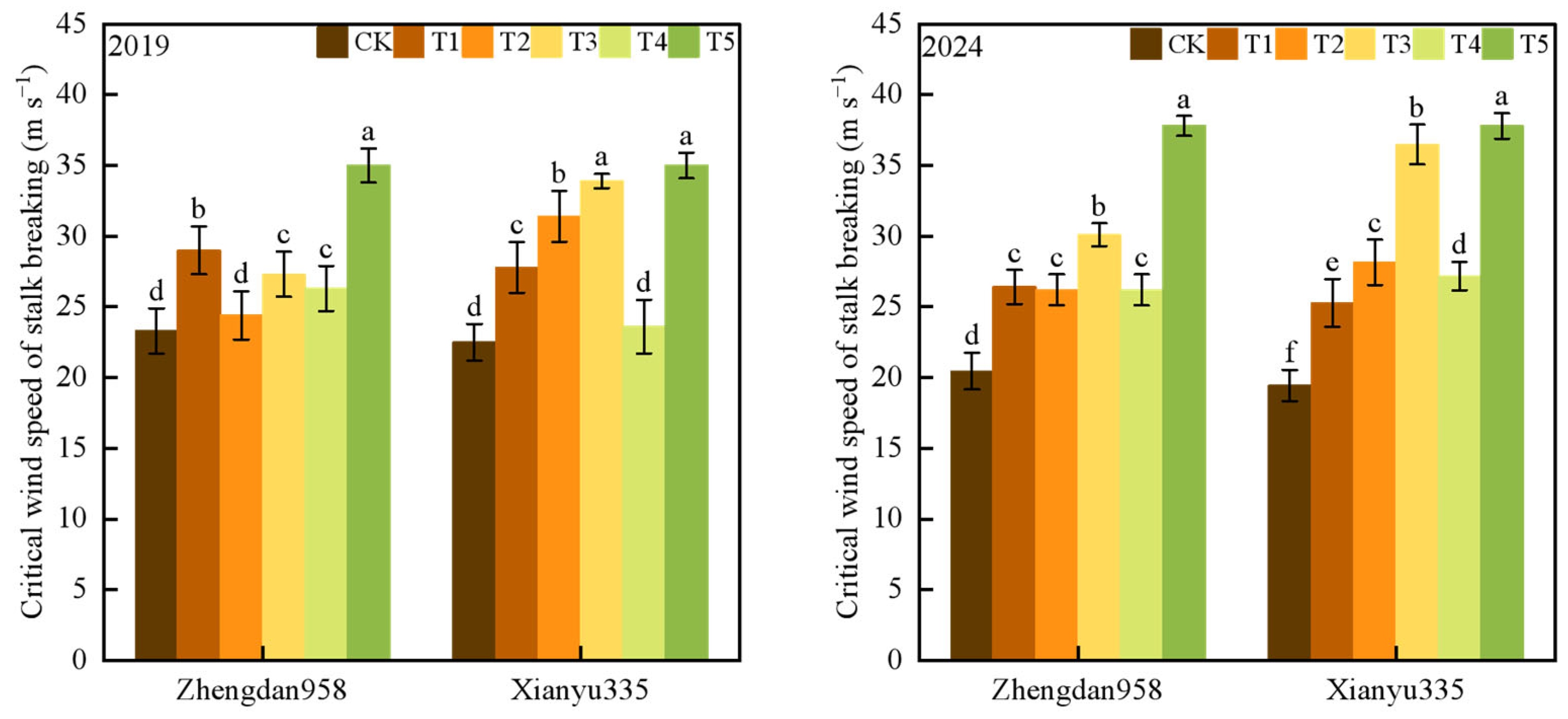
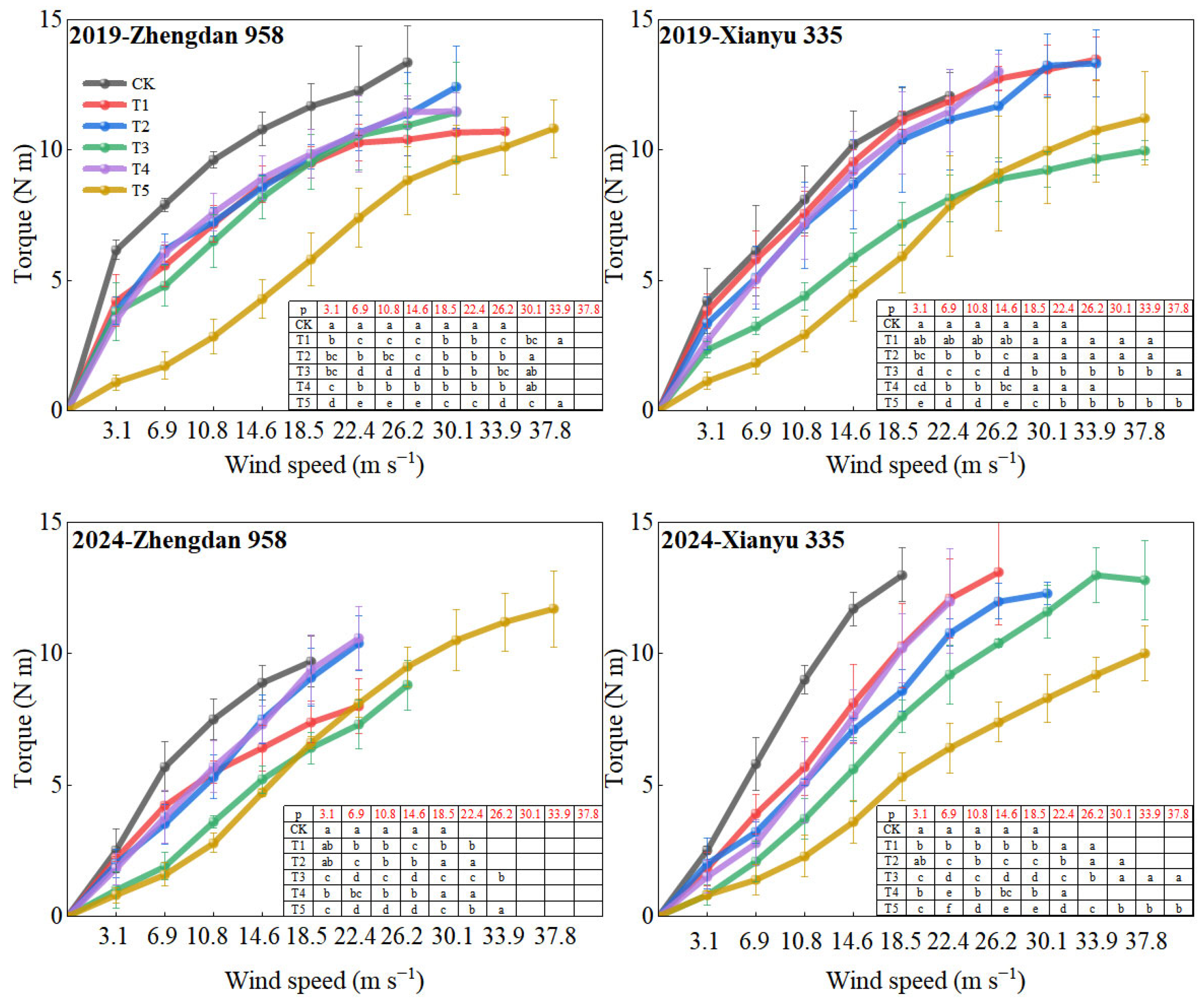
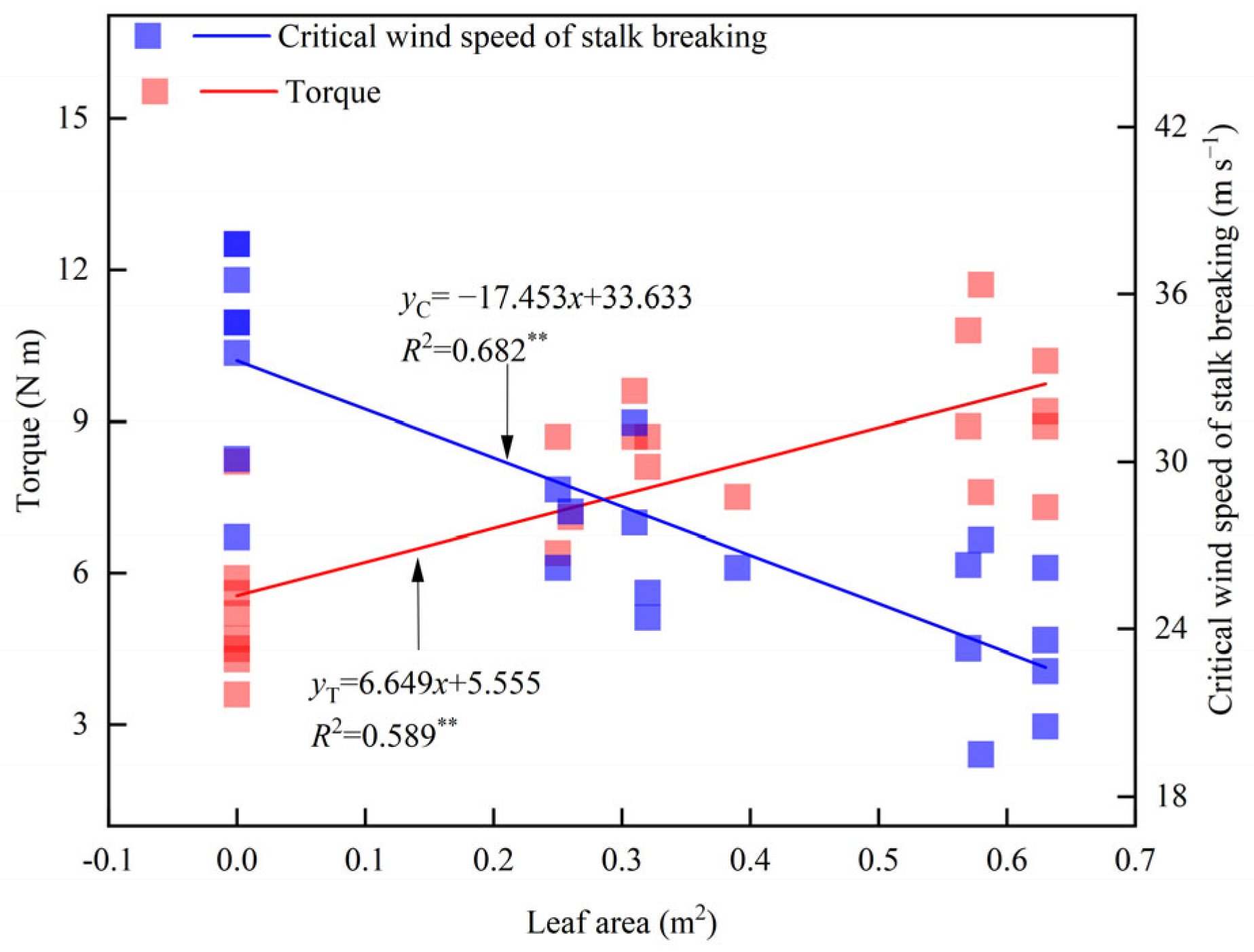
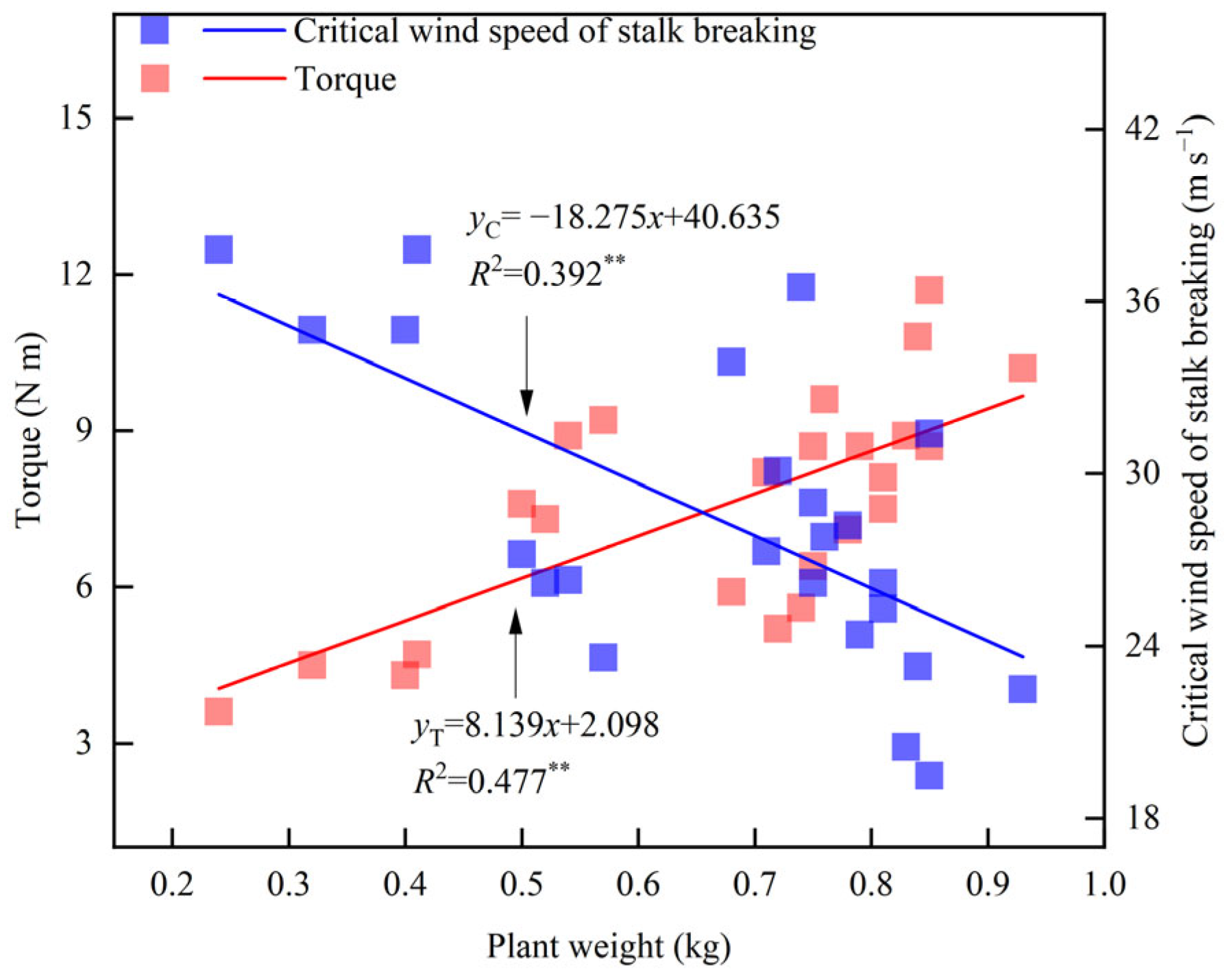
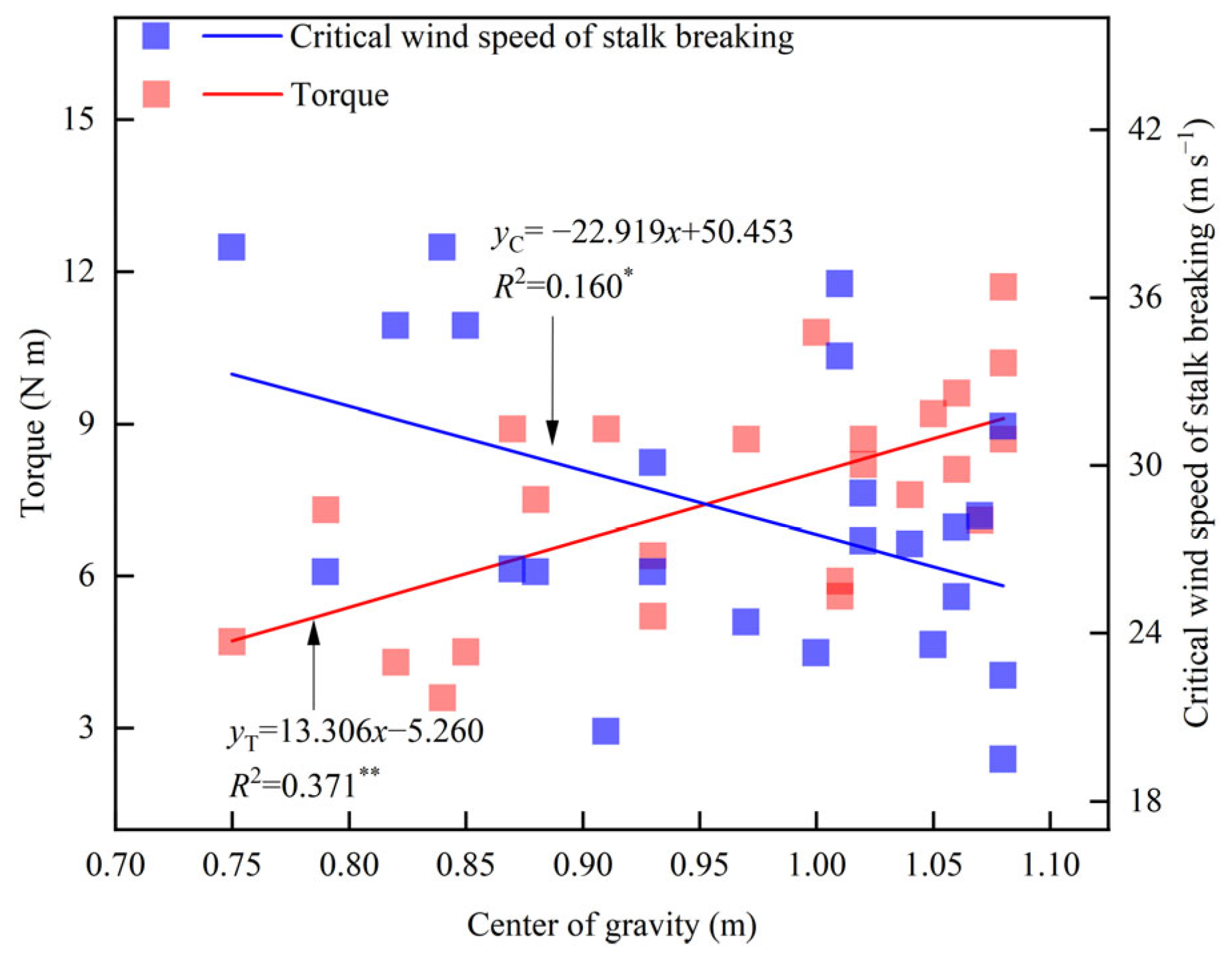
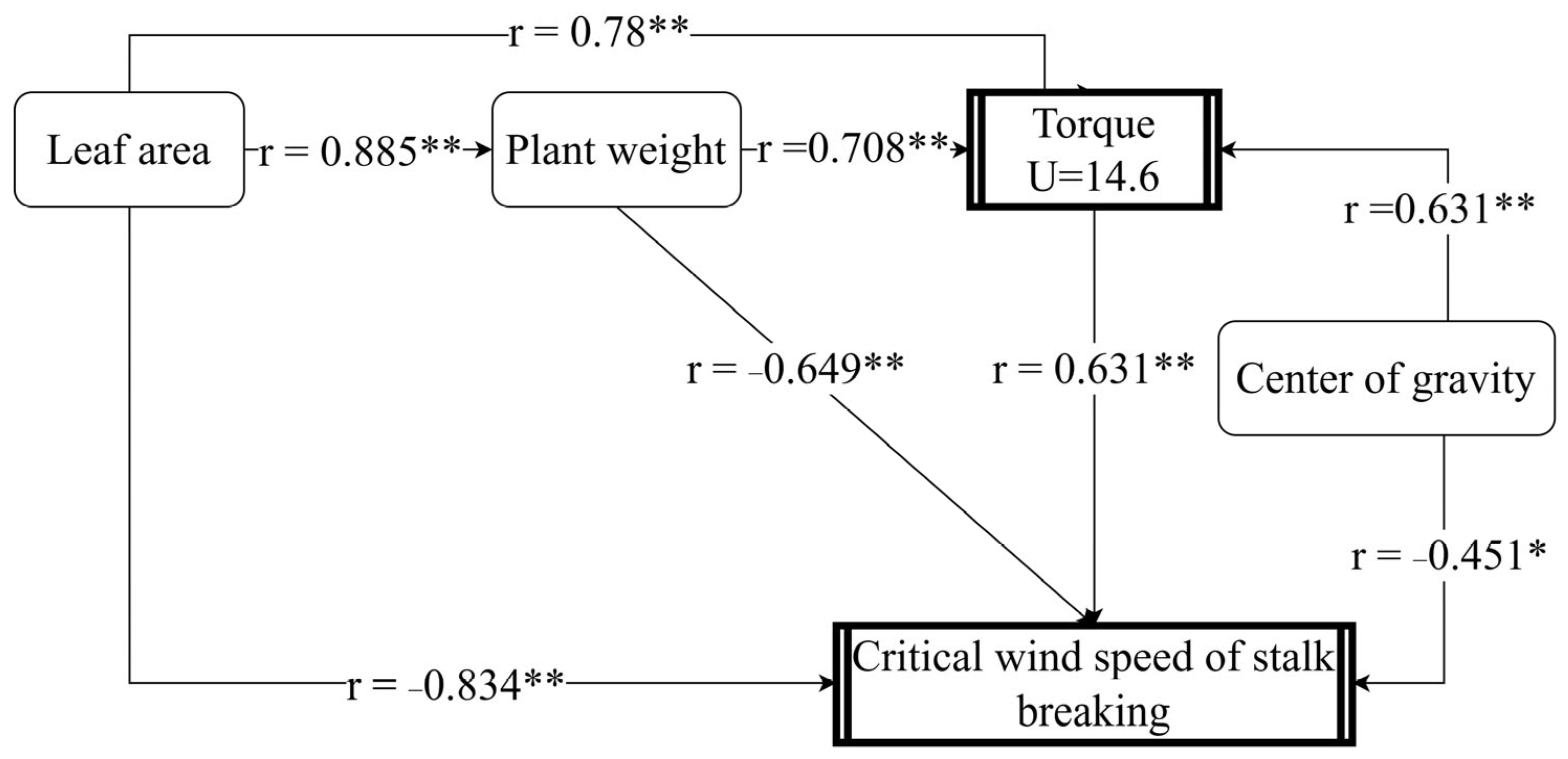
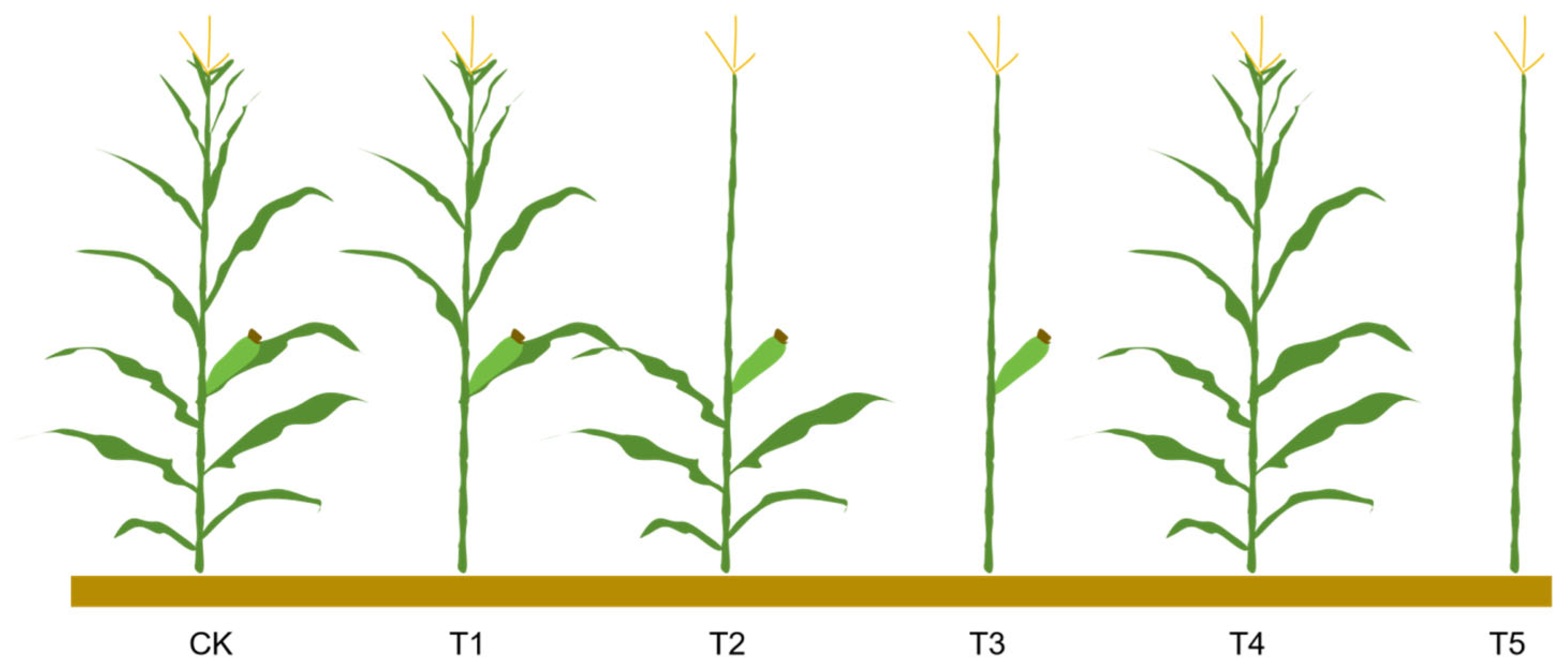
| Critical Wind Speed of Stalk Breaking | |
|---|---|
| TorqueU=3.1 (n = 24) | −0.577 ** |
| TorqueU=6.9 (n = 24) | −0.783 ** |
| TorqueU=10.8 (n = 24) | −0.847 ** |
| TorqueU=14.6 (n = 24) | −0.86 ** |
| TorqueU=18.5 (n = 24) | −0.821 ** |
| TorqueU=22.4 (n = 24) | −0.713 ** |
| TorqueU=26.2 (n = 21) | −0.79 ** |
| TorqueU=30.1 (n = 19) | −0.589 ** |
| TorqueU=33.9 (n = 14) | −0.419 ns |
| TorqueU=37.8 (n = 6) | −0.286 ns |
| Variety | Treatment | Leaf Area (m2) | |
|---|---|---|---|
| 2019 | 2024 | ||
| Zhengdan 958 | CK | 0.57 ± 0.06 a | 0.63 ± 0.04 a |
| T1 | 0.25 ± 0.02 c | 0.25 ± 0.03 c | |
| T2 | 0.32 ± 0.05 b | 0.39 ± 0.03 b | |
| T3 | 0 | 0 | |
| T4 | 0.57 ± 0.06 a | 0.63 ± 0.04 a | |
| T5 | 0 | 0 | |
| Xianyu 335 | CK | 0.63 ± 0.03 a | 0.58 ± 0.06 a |
| T1 | 0.31 ± 0.04 b | 0.32 ± 0.03 b | |
| T2 | 0.31 ± 0.02 b | 0.26 ± 0.04 c | |
| T3 | 0 | 0 | |
| T4 | 0.63 ± 0.03 a | 0.58 ± 0.06 a | |
| T5 | 0 | 0 | |
| Variety | Treatment | Plant Fresh Weight (kg Plant −1) | |
|---|---|---|---|
| 2019 | 2024 | ||
| Zhengdan 958 | CK | 0.84 ± 0.07 a | 0.83 ± 0.09 a |
| T1 | 0.75 ± 0.03 b | 0.75 ± 0.06 b | |
| T2 | 0.79 ± 0.08 b | 0.81 ± 0.07 a | |
| T3 | 0.71 ± 0.06 c | 0.72 ± 0.07 b | |
| T4 | 0.54 ± 0.05 d | 0.52 ± 0.04 c | |
| T5 | 0.40 ± 0.01 e | 0.41 ± 0.06 d | |
| Xianyu 335 | CK | 0.93 ± 0.05 a | 0.85 ± 0.07 a |
| T1 | 0.76 ± 0.09 c | 0.81 ± 0.02 ab | |
| T2 | 0.85 ± 0.05 b | 0.78 ± 0.06 bc | |
| T3 | 0.68 ± 0.08 d | 0.74 ± 0.08 c | |
| T4 | 0.57 ± 0.03 e | 0.50 ± 0.06 d | |
| T5 | 0.32 ± 0.02 f | 0.24 ± 0.03 e | |
| Variety | Treatment | Center of Gravity (m) | |
|---|---|---|---|
| 2019 | 2024 | ||
| Zhengdan 958 | CK | 1.00 ± 0.002 c | 0.91 ± 0.003 b |
| T1 | 1.02 ± 0.001 b | 0.93 ± 0.008 a | |
| T2 | 0.97 ± 0.002 d | 0.88 ± 0.002 c | |
| T3 | 1.02 ± 0.003 a | 0.93 ± 0.002 a | |
| T4 | 0.87 ± 0.001 e | 0.79 ± 0.002 d | |
| T5 | 0.82 ± 0.005 f | 0.75 ± 0.006 e | |
| Xianyu 335 | CK | 1.08 ± 0.004 a | 1.08 ± 0.005 a |
| T1 | 1.06 ± 0.002 c | 1.06 ± 0.005 c | |
| T2 | 1.08 ± 0.001 b | 1.07 ± 0.002 b | |
| T3 | 1.01 ± 0.001 e | 1.01 ± 0.004 e | |
| T4 | 1.05 ± 0.005 d | 1.04 ± 0.001 d | |
| T5 | 0.85 ± 0.005 f | 0.84 ± 0.001 f | |
| Wind Speed (m s−1) | Regression Equation | R2 | n |
|---|---|---|---|
| U = 3.1 | y = 4.211 x2 − 0.341 | 0.307 * | 24 |
| U = 6.9 | y = 3.622 x1 + 4.533 x2 + 0.012 | 0.61 ** | 24 |
| U = 10.8 | y = 4.681 x1 + 5.3 x2 + 0.863 | 0.746 ** | 24 |
| U = 14.6 | y = 5.092 x1 + 5.507 x2 + 2.332 | 0.785 ** | 24 |
| U = 18.5 | y = 5.375 x1 + 9.392 x3 − 1.657 | 0.819 ** | 24 |
| U = 22.4 | y = 4.485 x1 + 8.748 x3 + 0.276 | 0.763 ** | 24 |
| U = 26.2 | y = 4.993 x1 + 7.177 x3 + 2.749 | 0.755 ** | 21 |
| U = 30.1 | y = 6.263 x1 + 9.987 | 0.485 ** | 19 |
| U = 33.9 | y = 4.482 x2 + 8.756 | 0.349 * | 14 |
| U = 37.8 | - | - | 6 |
Disclaimer/Publisher’s Note: The statements, opinions and data contained in all publications are solely those of the individual author(s) and contributor(s) and not of MDPI and/or the editor(s). MDPI and/or the editor(s) disclaim responsibility for any injury to people or property resulting from any ideas, methods, instructions or products referred to in the content. |
© 2025 by the authors. Licensee MDPI, Basel, Switzerland. This article is an open access article distributed under the terms and conditions of the Creative Commons Attribution (CC BY) license (https://creativecommons.org/licenses/by/4.0/).
Share and Cite
Cao, Y.; Tian, M.; Gao, S.; Ming, B.; Wang, K.; Yu, H.; Li, S.; Xue, J. Maize Plant Morphology Affects Resistance to Stalk Breaking by Affecting Plant Stress. Plants 2025, 14, 1598. https://doi.org/10.3390/plants14111598
Cao Y, Tian M, Gao S, Ming B, Wang K, Yu H, Li S, Xue J. Maize Plant Morphology Affects Resistance to Stalk Breaking by Affecting Plant Stress. Plants. 2025; 14(11):1598. https://doi.org/10.3390/plants14111598
Chicago/Turabian StyleCao, Yujie, Ming Tian, Shang Gao, Bo Ming, Keru Wang, Haibing Yu, Shaokun Li, and Jun Xue. 2025. "Maize Plant Morphology Affects Resistance to Stalk Breaking by Affecting Plant Stress" Plants 14, no. 11: 1598. https://doi.org/10.3390/plants14111598
APA StyleCao, Y., Tian, M., Gao, S., Ming, B., Wang, K., Yu, H., Li, S., & Xue, J. (2025). Maize Plant Morphology Affects Resistance to Stalk Breaking by Affecting Plant Stress. Plants, 14(11), 1598. https://doi.org/10.3390/plants14111598







